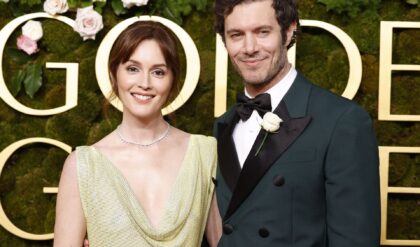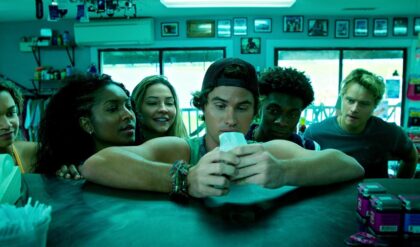After “Wheel of Fortune” host Pat Sajak, it’s Seacrest to the rescue — again.
Ryan Seacrest arrives at an “American Idol” even in Los Angeles on April 22. (Jordan Strauss/AP)
In the last years of radio’s role as the nation’s dominant musical tastemaker, Ryan Seacrest, America’s vanilla uber-host, took over Casey Kasem’s role as DJ on “American Top 40.” When Dick Clark was fading away as the nation’s faithful New Year’s Eve companion, Seacrest succeeded him, too. Seacrest has followed LA’s legendary radio morning DJ, Rick Dees, and TV’s legendary morning chat show host, Regis Philbin. And now, in the dying days of broadcast TV’s role as the bonding agent in America’s living rooms, Seacrest has been tapped to replace Pat Sajak, who hosted “Wheel of Fortune” for a mind-numbing 41 years.
For a man who once noted of himself that he has “no real talent,” Seacrest has done okay, both as a replacement for aging celebrities and in his gig hosting “American Idol.” At 49, he is not exactly a teen heartthrob, but he has become the go-to heir to boomer-era institutions because he is widely famous and relatively inoffensive to the generations that grew up amid a crumbling national monoculture.
In this era of polarized politics, collapsing trust in traditional institutions and lost local affinities, the machinery of American celebrity is struggling to churn out stars whose appeal bridges generational, political and class divides. Result: an increasingly geriatric culture, occasioned not only by the big population bulge of the boomers but also by the technological revolution that diminished gatekeepers’ roles in media, politics and the economy.
YouTube, social media and Spotify are more democratic purveyors of pop culture than Dick Clark, Ed Sullivan or Larry King ever were, but they don’t produce what used to be called household names. That leaves us in a place where all 10 of the 10 most popular TV personalities, as measured in surveys by YouGov, are either dead or over 65, from the late game-show hosts Alex Trebek and Bob Barker to retired late-night hosts David Letterman and Jay Leno and veteran TV personalities Vanna White and Steve Harvey. You have to reach down to No. 15 to find Jimmy Fallon, a mere pup at 49.
Ah, but linear TV is fading before our eyes, you say. True, yet even the stars of TV’s most popular shows now barely move the likeability needle, according to Steve Levitt, president of Marketing Evaluations, which produces the Q scores that sponsors use to measure celebrities’ emotional appeal.
“People love ‘Yellowstone’ and its cast, but they don’t really know who they are,” Levitt told me. “Stars of the big shows now have recognition scores only in the 30 percent range,” compared with 60 percent for Sajak — and 70 percent for Seacrest. “Where will the next stars come from? Hard to say.”
Virtually everyone knew of Trebek, but his successor on “Jeopardy!,” Ken Jennings, despite being one of the winningest game show contestants in history, is recognized by only 45 percent of those surveyed. And Jennings’s negatives are double his positives in likeability.
Share this articleShare
If that combination — famous name, unloved character — sounds familiar, consider our politics. No matter who wins, a widely unpopular octogenarian will serve in the White House next term. Geriatric America’s power structure is old, from the Senate, where the median age is the highest ever, to medicine, big business and much of the economy.
The phenomenon is most visible in the entertainment world — with the exceptions of sports and music, where star rosters are naturally refreshed, since most people lock in their fandom and musical taste in their youth. (Still, the top of the musical heap is disproportionately old — three of the 10 highest-grossing concert tours of all time starred senior citizens: late-career shows by the Rolling Stones and Elton John.)
Hollywood might be the most extreme example of the aging of American star power. The past year’s flicks featured actors who predate the boomers: At 80, Robert De Niro headlined a film by Martin Scorsese, also then 80. At 81, Harrison Ford appeared in his fifth Indiana Jones adventure. Tom Cruise’s impossible mission has carried him into his 60s. Asked which actors would draw them to a theater, moviegoers’ top 20 choices included two octogenarians and no one under 35.
The cultural flip tracks a population shift: In the next decade, the United States will be home to more people over 65 than those under 18 — the opposite of what everyone alive today has experienced.
The good news is that fresh ideas and fascinating mini-stars flourish online; influencers and creators grasping toeholds in the attention economy. But other than the Super Bowl, there’s little mass left. The “Wheel” audience that Seacrest inherits has shrunk from 40 million at its 1980s peak to about 9 million viewers a night.
In politics as in entertainment, mass culture can be as vanilla as Seacrest. But shared experiences and the inspiration generated by admirable popular figures can also bring us together. The country would gain a measure of health, politically and culturally, if more alternatives were available when the likes of Joe Biden, Donald Trump, Oprah Winfrey and Tom Hanks leave the stage. But the era of Walter Cronkite, Johnny Carson and Bob Barker isn’t coming back. The next generation of unifying personalities will have to coalesce from the shards of our collapsed community.






